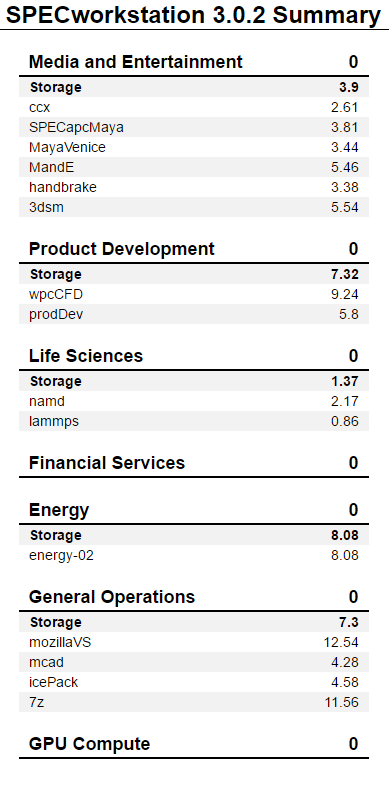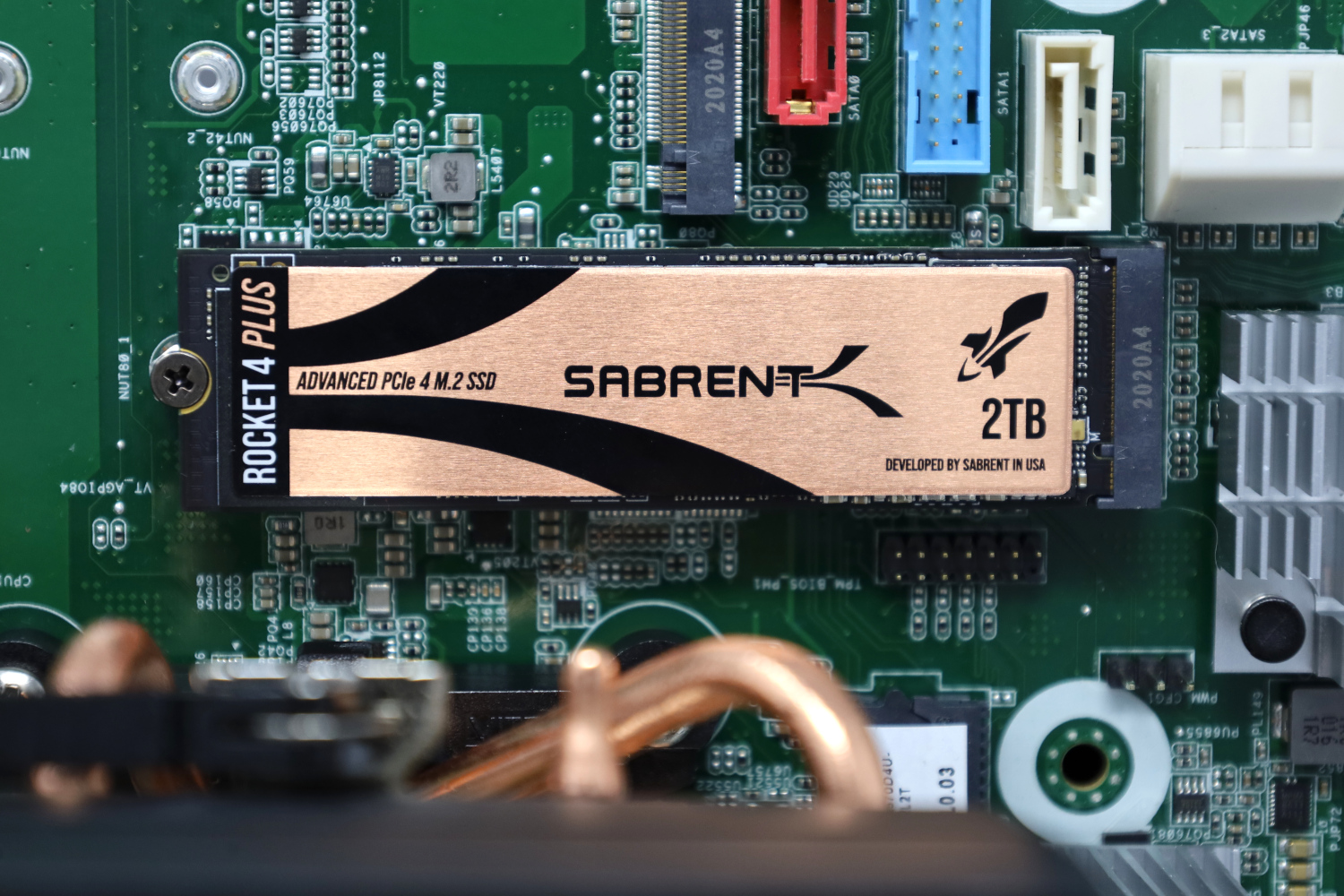SPECworkstation 3.0.2 Storage Benchmark
SPECworstation benchmark is an excellent benchmark to test systems using workstation type workloads. In this test, we only ran the Storage component, which is fifteen separate tests.


We sort this chart by the Product Development sub-score, where the Sabrent Rocket 4 Plus 2TB takes a small win over our previous best scores. On some of the other sub-tests though, such as Energy and General Operations, the margin of victory is much larger. Overall, the drive is a great performer in SPECworkstation, taking the top score in many of the subtests.
Temperatures
We monitored the idle and maximum temperature during testing with HWMonitor to get some idea of the thermal performance and requirements of the drive. Please keep in mind that our test bench is an open frame chassis in a 22C room, but with no direct airflow. As a result, this is not representative of a cramped low airflow case and is instead intended to model temperatures of a drive ‘on its own’.

This drive runs hot. Sabrent also sent a heatsink, which this drive needs when pushed under intensive loads. In truth, the drive may get even hotter, but the drive hit 70+ relatively quickly and I was not yet done with my full suite of benchmarks, so I halted testing and applied the heatsink. With the heatsink and a small amount of airflow, temperatures peaked at a much more reasonable 55C, and all the benchmark results included in this review are from the drive in the heatsink. We should also mention that many motherboards have their own cooling solutions which we would recommend over running this drive with no cooler at all.
Final Words
The Sabrent Rocket 4 Plus 2TB is $400, which puts it at a small price premium compared to other 2TB PCIe 4.0 SSDs like the Seagate Firecuda 520, Corsair Force MP600, and the last-gen Rocket NVMe 4.0, all of which are between $370 and $380. Compared to 2TB PCIe 3.0 SSDs, many of which are available for closer to $230, the Sabrent Rocket 4 Plus 2TB is downright expensive.
With the cost in mind, though, you get what you pay for. The Sabrent Rocket 4 Plus 2TB is the fastest consumer drive we have ever tested. It is much faster than the first generation of PCIe 4.0 SSDs, and often times twice as fast as the best PCIe 3.0 SSDs, so perhaps it has earned its price tag.

If you want the best performance possible, and you are willing to pay for it, then the Sabrent Rocket 4 Plus 2TB may be the drive for you. As long as you make sure the drive is adequately cooled under extended load, and do not need the extra endurance rating from the previous generation of Rocket NVMe 4.0 drives, then the Rocket 4 Plus is vying for the king of the SSD hill and is well worth your consideration.




Impressive drive. If this holds up on the datacenter side, lots of people are going to get their links saturated soon. On a side note, I’d like to know when we can start expecting general availability of PCIe 4 datacenter drives, such as Kioxia’s CD6 and Samsung’s offering (if they’ve announced one yet).
Consumer drives like this have excellent performance, but some PCIe 4 write-optimized drives with PLP will be a welcome sight.
Trim $150 off the price and get back to us! :)
Hello Will,
Can you try and test the sabrent m.2 with a pci nic? I tried the same m.2 in several server mb but could not get it past the pci enumeration during boot up. This only happened when we had a nic card in one of the pci slots. The same boards worked correctly with the non-plus version of their same m.2. the sabrent rocket plus would boot properly whenever we removed all of the nics. the specific motherboards that we tried were the asrockrack romed8, tyan dual socket rome server (long ass model #!) and supermicro h12ssw-in. All with the same issue, wouldn’t boot when there was any nic (specific nic was a mellanox connectx5-516-cdat dual port 100G pcie 4.0). take all of the nics out and would boot fine. we also did not have any issues with the previous gen of sabrent rocket 1TB (non-plus) gen 4. It was very fast when we removed the nics but couldn’t resolve this issue. we are not sure if it was just a bad m.2 or maybe an issue with nvme 1.4 or 2TB or a combo. Have the 2TB WD black 850 on order to compare.
Thanks for the review and any insight you can add,
jp
I’m pretty sure a AMD Ryzen 5 3900X doesn’t exist.
Bob,
Fixed.
“Trim $150 off the price and get back to us!”
Really? What nvme at $250 that is 2TB can even compare to the performance of this drive? In fact its a bit cheaper than the competition that is near that level.
@Mharris. It is the NAND that is by far the largest cost in the BOM, probably over 85 % of the BOM if not 90 % . The only reason they can charge double price for same capacity as PCIE 3.0 drive is because of lack of competition currently. They even use less expensive and lower endurance NAND than previous generation (Samsunf and WD are doing the same) when you think of it the price is actually completely crazy.
@Rodi…again, look at the market, why would they price it even lower when Samsung and WD with comparable drives are priced higher, THAT is my point. I am not talking about what the price should be for all of them, that is a different story of course.
I’m curious about this as a secondary gaming drive. I still feel that something like an Optane is better (Despite lower overall performance) for OS work. Single threaded, random I/O stuff nothing touches the 905p still. I wish Alder Stream would break cover and give us an upgraded option with larger storage.
I would like to see WD SN850 2TB charts with Game Mode On with Latency Test compared to Rocket Plus 2TB. I heard Sn850 is 2 second faster when loading Windows10 and games.